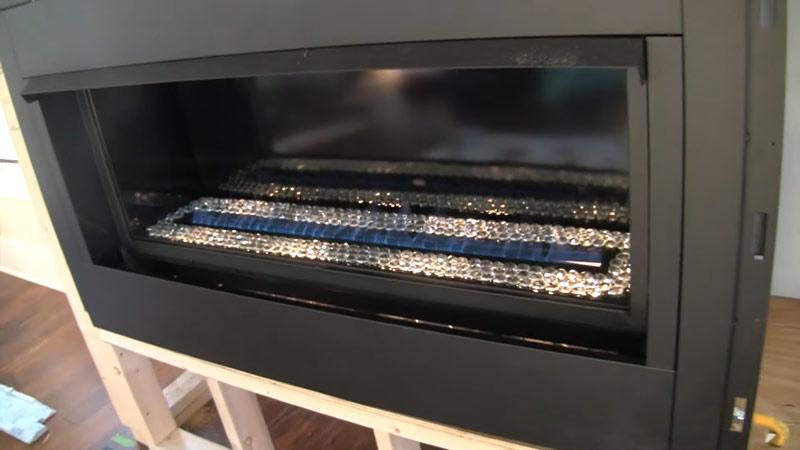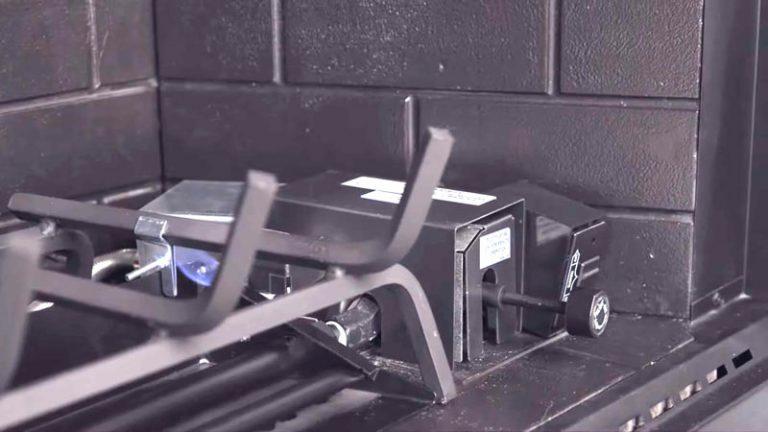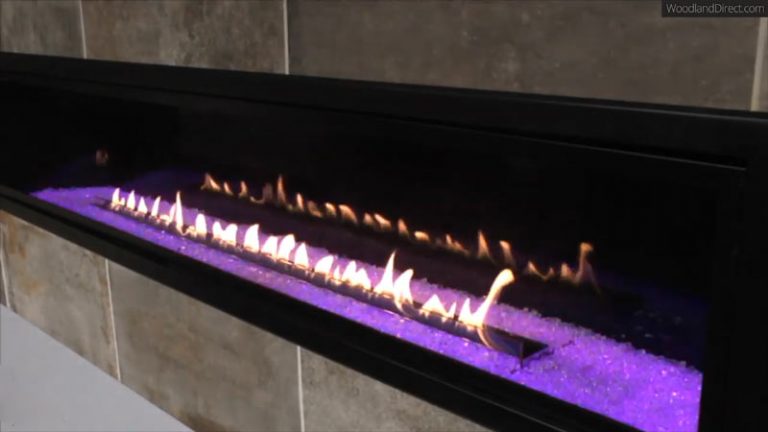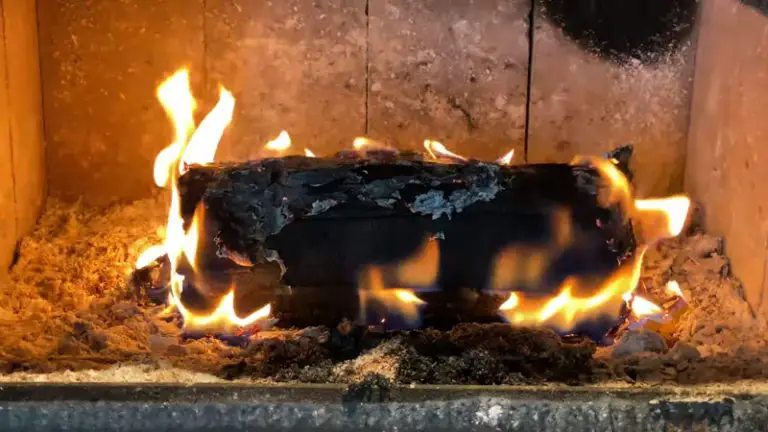How Does A Ventless Gas Fireplace Work

If you’re looking for a dramatic change in air quality, an interior fireplace may not be the best decision for you. All emissions released from ventless fireplaces are inside the room they operate- no outdoor pollutants reach your home.
Not only is this type of fireplace bad for your health, but it also increases the risk of asthma symptoms and health risks to children and pets in your home. A better option would be an electric or gas-fired stove that uses less air pollution and has little to no impact on indoor air quality- perfect if you have allergies or other respiratory issues.
You'll Learn About
How Does A Ventless Gas Fireplace Work?
A ventless fireplace uses interior air for combustion, yielding dramatically decreased air quality that you breathe in. All emissions are released inside the room they operate- increasing the health risks to yourself and your family.
Children and pets are at increased risk when using an open flame indoors, even with a ventless fireplace – be sure to research safety precautions before making this decision.
Ventless Fireplaces Use Interior Air For Combustion
A ventless gas fireplace uses interior air for combustion, which means that there is no need for a chimney or flue. The fire is fueled by an electrical generator and then heated by the flames.
This type of fireplace can be placed almost anywhere in your home because it doesn’t require any special installation or wiring. You’ll need to purchase a separate appliance (like an outdoor grill) to use with a ventless gas fireplace; this isn’t necessary with similar models designed for indoor use only.
Ventless gas fireplaces are safe to operate, but you should always read the manufacturer’s instructions before using them – especially if you’re not familiar with how fires work.
All Emissions Are Released Inside The Room They Operate
A ventless gas fireplace operates by burning natural gas and using the heat to generate warmth inside of the room. The fire is contained within a glass bowl, which allows you to see it without opening the door.
To use the fireplace, all you have to do is turn on the ignition and wait for it to warm up before entering your room. There are no emissions released into your home when using this type of fireplace – it’s completely safe.
This type of fireplace is perfect if you want an element that will add some extra warmth to your home but don’t want any smoke or fumes coming into your living space.
Dramatically Decreasing The Air Quality You Breathe
A ventless gas fireplace does not require the use of a chimney, which dramatically decreases air quality in your home. The fire is lit and controlled using an electronic control panel instead of a traditional flue system.
Ventless gas fireplaces are typically less expensive to operate than traditional models, making them a good choice for smaller spaces or apartments with limited heating space. They can be used indoors or outdoors and come in both wood-burning and electric variants.
Know the emissions levels produced by different types of ventless gas fireplaces before purchasing to make sure they meet your specific needs.
Increased Risk Of Asthma Symptoms
A ventless gas fireplace emits noxious fumes that can increase the risk of asthma symptoms in individuals with sensitive respiratory systems. Make sure to read the manufacturer’s instructions before using your new gas fireplace, especially if you have a sensitive respiratory system.
If you experience breathing problems after using your ventless gas fireplace, consult an allergist for help diagnosing and managing your condition. Keep all embers and ashes out of reach of children and pets; they could consume these substances and develop lung cancer or asthma as a result of it.
Always use caution when operating any type of gas-fired appliance — even those without vents.
Health Risks In Children And Pets
A typical gas fireplace uses combustion to heat the room. This creates hazardous air pollutants, including carbon monoxide and nitrogen dioxide, at levels that can be harmful to your health and well-being.
Children and pets are particularly at risk when living near a gas fireplace; they may not understand how dangerous it can be if they’re attracted to the fire. If you have a ventless gas fireplace, make sure all of the safety features are working properly by regularly checking for leaks or malfunctions.
If you do experience any breathing difficulties or problems with your pet after using your ventless gas fireplace, consult an expert for help.
Which is better vented or ventless gas fireplace?
There is no right or wrong answer when it comes to choosing whether a gas fireplace should have vents or not. The main advantage of having vents is that they allow the fire to breathe, which means it will be more efficient and last longer.
On the other hand, ventless gas fireplaces don’t need any openings because they use heat radiation instead of flames.
- A vented gas fireplace uses more energy than a ventless gas fireplace. Ventless fireplaces use an airtight system that allows the heat from the burning fuel to escape, which is much more efficient than using a vented system where the flue gases are released into the atmosphere.
- A ventless gas fireplace can be used in any room, as opposed to a vented gas fireplace, which is best suited for large rooms with high ceilings and wide open spaces.
- There’s no need to clean a vented gas fireplace flue because it uses natural convection cooling instead of forced air ventilation like in a traditional furnace or wood-burning stove. This means that there is little chance of build-up and clogging over time, making this type of heating solution one of the most maintenance-free on the market today.
- You may lose some heat when your conventional furnace or wood-burning stove isn’t operating due to its lack of vents (a typical Gas Fireplace has 1/3rd fewer combustion chambers), but you’ll never have this problem with an indoor ventless unit – they work by drawing warm air up through strategically placed holes and releasing it outdoors without ever letting hot gasses enter your home again.
- Finally, if you’re considering investing in an indoor ventless gas heater but aren’t sure if it’s right for you – think about how often you plan on using your new appliance and whether having less visible equipment will affect your decorating style.
How long can you run a vent free gas fireplace?
If you own a vent-free gas fireplace, it’s important to know how long you can run the unit without needing to open the vents. Over time, the heat from the fire will build up and eventually cause the glass plates in your fireplace to warp.
This can make it difficult or impossible to use your gas fireplace. If you’re considering installing a ventless gas fireplace in your bedroom, you should not do it. A ventless gas fireplace shouldn’t be installed in any room where there is an open flame such as a bedroom or living room.
This type of fireplace should only be run for two hours at a time and the space where it’s installed must have enough square footage to accommodate the installation. You need to make sure that your bedroom has enough square footage to accommodate an installation of a ventless gas fireplace.
The size of these fireplaces can vary so make sure that you measure the area before making your purchase decision. Always use caution when using any kind of open flame in your home, even if it’s a small stovetop burner like those used on most ventless gas fireplaces. Make sure to keep combustible materials (such as curtains) at least 2 feet away from the flames on all types of stoves including ventless gas fireplaces.
And finally, always use a screen when burning wood inside your house – even with Vent-Free Gas Fireplace installations.
Can a ventless gas fireplace be vented?
A ventless gas fireplace can’t be vented, and there is no way.
A ventless gas fireplace cannot be vented
A ventless gas fireplace is a type of stove that uses combustion instead of an open flame to produce heat. These stoves do not have vents, so they rely on the flow of air into and out of the firebox to circulate the heated air.
This means that a ventless gas fireplace cannot be vented, which can lead to problems such as poor ventilation and high temperatures in the room.
You would have to replace the existing Ventless Fireplace
If you want to use a ventless gas fireplace in your home, you will need to purchase an entirely new unit rather than trying to retrofit an existing one. In addition, it is not a good idea to install a ventless gas fireplace near children or pets because they could potentially get hurt if there was an accident involving hot flames or sparks from the firebox.
If your room gets too warm, you might also need to open windows for better ventilation.
Ventless Gas Fireplace Near Children Or Pets
Using an unvented gas fireplace near small children or pets can pose risks such as fires caused by careless movements or burns from hot embers landing on them accidentally. Similarly, using unvented gas fireplaces close enough to large animals (like cats) can result in them being burned when they jump onto furniture that has been placed over the burning logs.
Might Need To Open The Windows
When rooms become too warm with even minimal exposure ambient heat coming from burning appliances like this gas fireplace device such as windows may need to open to control the air.
Can a ventless fireplace make you sick?
Ventless fireplaces can be a great way to add warmth and ambiance to your home, but use caution when using them. Make sure your chimney is clean and free of obstruction before installing a ventless fireplace.
Install an alarm in case levels of carbon monoxide become high, and keep all windows closed while using the fireplace. Have enough fuel burning in the firebox at all times for optimum heat output and safety precautions Always have an escape plan if things go wrong.
Keep some basic safety tips handy when using any type of fireplace- such as having an escape plan- so you can enjoy this beautiful winter season safely.
Are ventless fireplaces Safe in this Year?
Ventless gas fireplaces may emit dangerous and noxious gasses into the room they are operating. However, without proper ventilation and safety systems in place. There can be serious health risks associated with burning gas in a ventless fireplace.
Properly vented gas fireplaces do not pose any health risks, but it is still important to follow all safety precautions when using them. Without proper ventilation and safety systems in place, there could be serious health risks associated with burning gas in a ventless fireplace. So make sure to take these factors into account before making your purchase.
Always be aware of the dangers involved when using a ventless gas fireplace; make sure you have everything safeguarded by following all necessary precautions. Follow all relevant safety guidelines before installing or using a ventless gas fireplace- it’s better safe than sorry.
What states have banned ventless gas fireplaces?
Several states have banned ventless gas fireplaces, due to the potential for fires. These appliances use a fan to create a draft that sucks air into the burners.
If there is something obstructing the fan, then the draft will not be created and this can lead to an ignitable spark.
Unsafe
Ventless gas fireplaces are not safe and they should never be used in any type of home. These types of fires can cause serious injuries if they start accidentally. Additionally, these fires produce a lot of pollution which can harm the environment.
Cause Pollution
Ventless gas fireplaces actually produce more pollutants than traditional fireplace flames because there is no smoke stack to help control emissions.
This means that these appliances typically release higher levels of carbon dioxide, nitrogen oxides, and other dangerous gases into the air around them.
Can Be A Fire Hazard
Since ventless gas fireplaces have no chimney or flue system, they are very susceptible to catching on fire if something goes wrong with them (for example, if the flame gets too high).
In addition, these appliances often lack adequate safety features such as automatic shut-off systems and warning lights which could lead to disastrous consequences for anyone using them improperly.
Cost More Than Traditional Fireplaces
A traditional fireplace requires little maintenance over time while a ventless gas fireplace may need regular repairs due to its tendency to malfunction quickly.
Finally, traditional brick or stone fireplace may cost less upfront but you will likely spend more in long-run costs because replacement bricks/stones are necessary over time. These fireplaces are designed to burn fuel efficiently, minimizing harmful emissions. However, proper ventilation and regular maintenance are essential to ensure safety.
If you’re using a ventless fireplace, it’s worth learning what’s inside Duraflame 4-hour logs for alternative heating options. Additionally, understanding how to break Duraflame starter logs can help you manage your fireplace more effectively. For more tips, explore the easiest way to clean a chimney.
To Recap
A Ventless Gas Fireplace uses gas instead of logs or wood to create heat. The fire is lit by a pilot light and the gas flows through tubes in the front and back of the fireplace, burning the gas mixture which creates heat.



